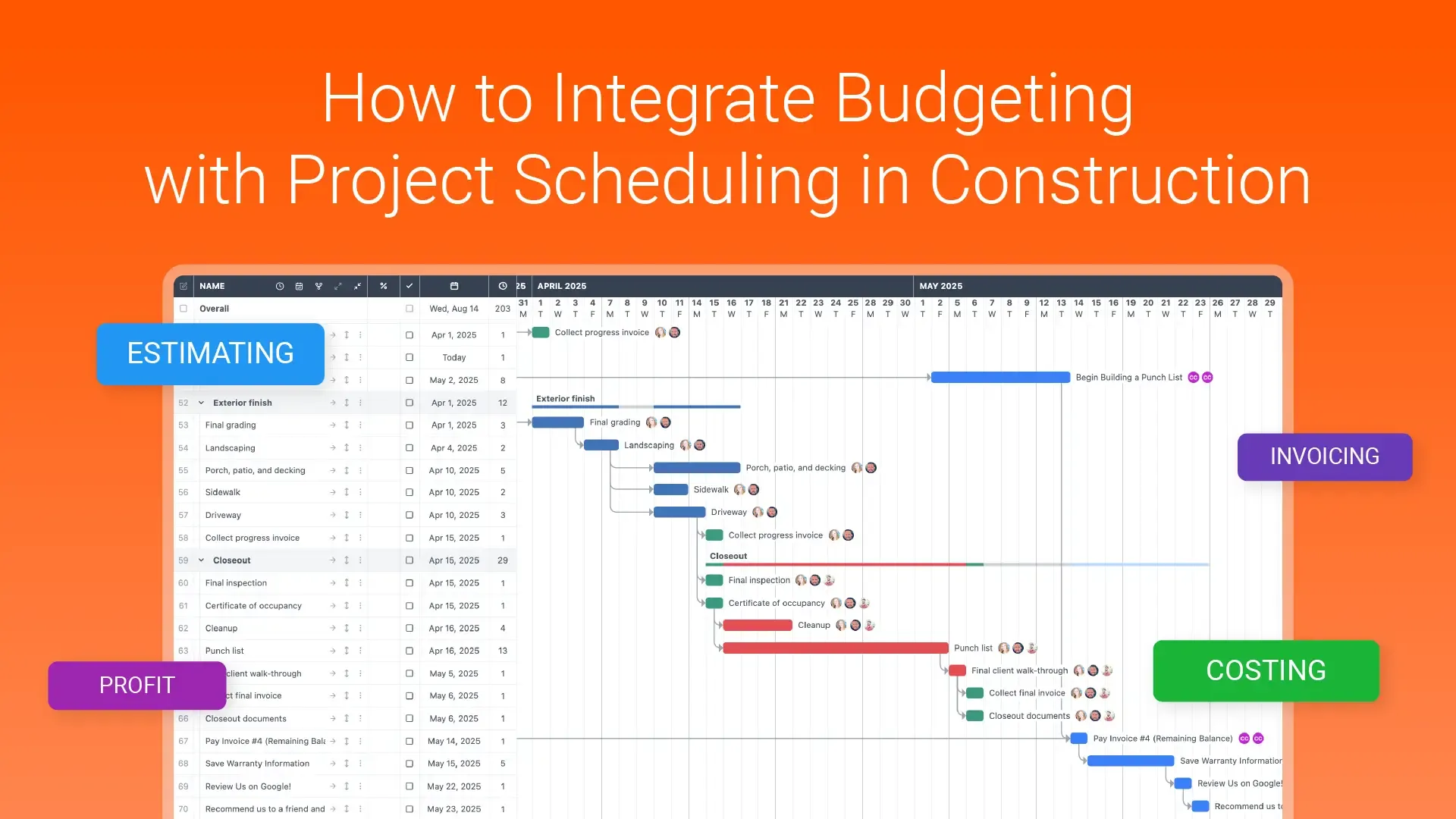How to Integrate Budgeting with Project Scheduling in Construction

Effective construction project management relies on two critical components: budgeting and scheduling. However, many contractors treat these as separate processes, which often leads to overspending, delays, and financial strain. Integrating your budget with your project schedule allows you to track costs in real time, align financial milestones with construction phases, and avoid budget blowouts. Let’s explore how you can integrate budgeting with scheduling for better project control.
Why Align Budgeting with Project Scheduling?
Construction projects are fluid, with shifting timelines, material availability, and labor dynamics. When your budget is not aligned with your schedule, it becomes difficult to track expenses accurately. This can result in:
- Overspending: If you don’t monitor costs as work progresses, you may exceed the budget before the project reaches completion.
- Delays: Misaligned timelines and budgets can lead to delays if critical materials or labor are not accounted for at key phases of the project.
- Profitability Issues: Without an integrated approach, it’s easy to miss financial milestones and overrun the budget, shrinking your profit margins.
Integrating your budget with your schedule helps you monitor project health continuously, preventing surprises and keeping your finances on track.
Learn How JobTread's Scheduling Helped Iconic Custom Home Builders Win a $300,000 Job
Read MoreSteps to Integrate Budgeting with Project Scheduling
Break the Project into Phases
The first step is to divide the construction project into logical phases. Each phase, such as excavation, framing, and finishing, should have its own timeline and associated costs. This allows you to track both time and money at each project milestone.
Best Practices:Align specific cost items with each project phase. For example, ensure that the labor costs for framing are tracked alongside the completion of the framing phase in your schedule.
Establish Financial Milestones
Set financial milestones that correspond to your project schedule. This means budgeting for specific parts of the project and associating those budget items with time-based goals. It helps you monitor whether the project is both on schedule and within budget as it progresses.
Best Practices:Create a calendar that highlights key financial and scheduling checkpoints. For example, if you know that 50% of your labor costs will be spent by the end of the framing phase, track those costs against your timeline to ensure they’re in line with expectations.
Monitor Labor and Material Costs in Real Time
As work progresses, material and labor costs can fluctuate. By tracking costs in real time and aligning them with your schedule, you can adjust as necessary before it becomes an issue. For instance, if labor costs are higher than expected at a particular phase, it may be necessary to revisit the schedule to reduce overtime or adjust resources.
Best Practices:Use construction budgeting software that syncs with your project schedule to provide real-time updates on both costs and timelines. This ensures you catch discrepancies early and avoid budget blowouts.
Track Change Orders Carefully
Change orders are a common source of financial and scheduling disruption. Every time a change order is approved, make sure the budget and timeline are updated accordingly. Failing to account for the extra costs and time required can throw off both your budget and schedule.
Best Practices:Ensure that your change order approval process includes automatic updates to both the budget and project schedule to minimize potential delays or additional costs.
Use Contingency Plans
Always build in contingencies for both the budget and schedule. This helps you plan for unforeseen events like weather delays, material shortages, or unexpected price increases.
Best Practices:Include contingency funds and time buffers in your project timeline to accommodate unexpected events, which can help keep the project moving forward without significant financial impact.
Benefits of Integrating Budgeting and Scheduling
- Enhanced Visibility: You gain real-time insights into project progress, helping you make informed decisions quickly.
- Cost Control: Aligning costs with schedule milestones helps prevent overspending and allows for quicker corrections.
- Improved Profitability: Keeping both time and expenses in check ensures that projects stay profitable without running over budget or past deadlines.
- Fewer Delays: Integrated scheduling and budgeting reduce the risk of project delays by ensuring that all financial resources are available when needed.
Conclusion: Consider Streamlining Your Projects with JobTread
Integrating budgeting with project scheduling is crucial for staying profitable and avoiding delays. JobTread’s software simplifies this by aligning your timelines with financial goals, offering real-time tracking of costs and milestones.
If you're looking to streamline operations and drive better financial outcomes, JobTread is the tool that delivers results. Schedule a demo today and see how JobTread can transform your business.
Elevate your company to new levels of success!
Let one of our experts show you how JobTread will get you organized, save your time, and increase your profits.
Book a Demo